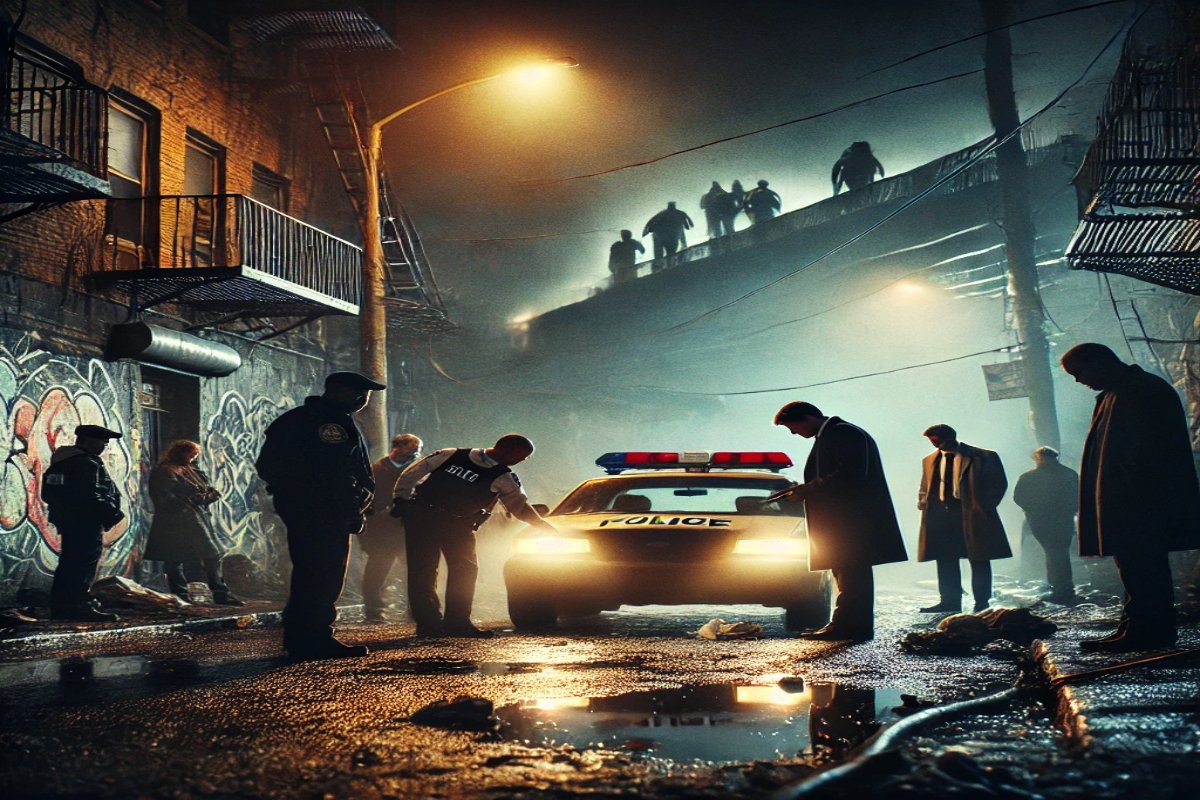In the landscape of television crime dramas, few series have managed to capture the complexity and grittiness of urban life as effectively as “The Wire.” Created by David Simon, this critically acclaimed HBO series offers an unflinching look at the drug trade and the institutions that grapple with it in Baltimore, Maryland. At the heart of “The Wire” is its debut season, which sets the stage for a deep dive into the interconnectedness of crime, law enforcement, politics, and society. Through its meticulous storytelling and richly developed characters, “The Wire Season 1” remains a benchmark for storytelling in television.
Background of “The Wire”
“The Wire” premiered on HBO in June 2002, a time when the network was making a name for itself with groundbreaking series like “The Sopranos” and “Six Feet Under.” Unlike traditional crime dramas that focused primarily on police work, “The Wire” aimed to portray the intricate web of social issues, political pressures, and economic forces that underpin the drug trade. David Simon, a former police reporter for The Baltimore Sun, drew upon his experiences and insights to craft a series that was as much a social commentary as it was a crime drama.
You Might Also Like: Olimpica Stereo Barranquilla: A Cultural Gem of Colombia
The Wire Season 1
Overview and Plot Summary
Season 1 of “The Wire” centers around a joint task force formed to investigate the drug-dealing operations of the Barksdale Organization, a powerful and elusive drug empire in West Baltimore. The series opens with the murder trial of D’Angelo Barksdale, a nephew of the organization’s leader, Avon Barksdale. Despite being acquitted due to witness intimidation, D’Angelo is demoted within the organization, marking the beginning of his struggle with the violent world of drug trafficking.
The task force, led by Detective Jimmy McNulty, employs unconventional methods to build a case against Avon Barksdale and his right-hand man, Stringer Bell. As they navigate bureaucratic obstacles and ethical dilemmas, the detectives resort to wiretaps and surveillance, providing a raw and realistic depiction of police work.
Setting and Atmosphere
Depiction of Baltimore in Season 1
The city of Baltimore is more than just a backdrop in “The Wire”—it is a character in its own right. Season 1 captures the urban decay and economic disparity that define much of Baltimore, painting a vivid portrait of a city struggling with systemic issues. The series meticulously recreates the streets, projects, and neighborhoods where the drug trade flourishes, using actual locations to enhance authenticity. This commitment to realism gives viewers an immersive experience, drawing them into the gritty realities of life in West Baltimore.
Character Analysis
Jimmy McNulty, Stringer Bell, Avon Barksdale
“The Wire” is renowned for its complex and multi-dimensional characters, each of whom adds depth to the narrative. In Season 1, three characters stand out as pivotal figures in the unfolding drama.
- Jimmy McNulty: A maverick detective with a penchant for bending the rules, McNulty is driven by a relentless pursuit of justice. His commitment to taking down the Barksdale Organization often puts him at odds with his superiors and personal life, highlighting his internal conflicts.
- Stringer Bell: As Avon Barksdale’s right-hand man, Stringer Bell is a calculating and business-savvy figure who seeks to legitimize the organization’s operations. His strategic mind and ambition set him apart from typical depictions of drug dealers, adding layers to his character.
- Avon Barksdale: The elusive and enigmatic leader of the Barksdale Organization, Avon is both feared and respected in the drug world. His control over the operation is absolute, yet his vulnerability emerges as law enforcement closes in on him.
Themes and Motifs
The Drug Trade, Corruption, and Surveillance
“The Wire” delves deep into themes that resonate throughout its first season and the entire series. At its core, the show examines the drug trade as a symptom of broader societal issues, such as poverty, unemployment, and lack of opportunity. The pervasive corruption within both the criminal and law enforcement worlds is a recurring motif, highlighting the blurred lines between right and wrong.
Surveillance plays a crucial role in Season 1, as the detectives rely on wiretaps and covert operations to gather evidence against the Barksdale Organization. This focus on technology underscores the changing landscape of police work and the ethical dilemmas associated with privacy and civil liberties.
The Realism of “The Wire”
Use of Authentic Language and Situations
One of the defining features of “The Wire” is its commitment to authenticity. The series eschews Hollywood glamour in favor of gritty realism, using authentic language and situations to portray the complexities of urban life. The dialogue reflects the vernacular of Baltimore’s streets, while the scenarios are drawn from real-life events and experiences. This dedication to realism creates a world that feels lived-in and believable, allowing viewers to connect with the characters and their struggles on a deeper level.
The Police Perspective
Focus on Detectives and Their Methods
Season 1 provides an intimate look at the lives of the detectives tasked with dismantling the Barksdale Organization. The series delves into their personal and professional challenges, exploring the toll that police work takes on their lives. From the relentless pursuit of justice to the moral ambiguities they face, the detectives’ journey is fraught with tension and complexity. “The Wire” offers a nuanced portrayal of law enforcement, emphasizing the dedication and sacrifices required to combat crime in a city plagued by violence.
The Criminal Element
Inside the Barksdale Organization
While “The Wire” provides a detailed account of the detectives’ efforts, it also offers a glimpse into the inner workings of the Barksdale Organization. Season 1 humanizes its criminal characters, presenting them as individuals with their own motivations, fears, and aspirations. This balanced portrayal challenges traditional narratives, forcing viewers to confront the harsh realities of the drug trade and its impact on those involved.
Key Episodes in Season 1
Highlights and Turning Points
Several episodes in Season 1 stand out as pivotal moments in the series. These episodes not only drive the plot forward but also deepen the thematic exploration of “The Wire.”
- “The Target”: The pilot episode sets the tone for the series, introducing key characters and establishing the central conflict between law enforcement and the Barksdale Organization.
- “The Wire”: The task force’s decision to employ wiretaps marks a turning point in their investigation, offering new insights into the organization’s operations.
- “Game Day”: Tensions rise as the stakes escalate, culminating in a high-stakes basketball game that mirrors the broader conflict between the police and criminals.
- “Cleaning Up”: The penultimate episode intensifies the pressure on both sides, leading to a series of dramatic developments that set the stage for the season finale.
- “Sentencing”: The season concludes with the resolution of key storylines, leaving viewers eager to see how the consequences will unfold in future seasons.
Critical Reception
Reviews and Cultural Impact
Upon its initial release, “The Wire” received critical acclaim for its ambitious storytelling and authentic portrayal of urban life. While it did not achieve high ratings during its initial run, the series gained a dedicated following and has since been hailed as one of the greatest television shows of all time. Critics praised its intricate narrative structure, complex characters, and unflinching examination of social issues. Over time, “The Wire” has become a cultural touchstone, influencing subsequent crime dramas and solidifying its place in television history.
Social Commentary
Insights into Urban Decay and Inequality
At its core, “The Wire” is a powerful social commentary on the systemic issues plaguing American cities. Season 1 sheds light on the cycle of poverty and violence that perpetuates the drug trade, exposing the deep-rooted inequalities that contribute to urban decay. Through its nuanced portrayal of characters on both sides of the law. The series challenges viewers to confront uncomfortable truths about race, class, and power. By highlighting the interconnectedness of institutions and individuals, “The Wire” encourages a broader understanding of the forces shaping modern society.
The Impact of Technology
Surveillance and Wiretaps
In Season 1, the use of technology plays a pivotal role in the investigation of the Barksdale Organization. The detectives’ reliance on wiretaps and surveillance equipment underscores the changing landscape of law enforcement, where technological advancements are both a boon and a challenge. This focus on technology raises important questions about privacy, civil liberties, and the ethical implications of intrusive surveillance methods. By exploring these themes, “The Wire” offers a thought-provoking examination of the balance between security and individual rights in the digital age.
The Role of Politics
Influence on Law Enforcement
Politics is a pervasive force in “The Wire,” shaping the decisions and actions of both law enforcement and criminals. Season 1 explores the influence of political pressures on police work, highlighting the challenges faced by officers who must navigate bureaucratic obstacles and shifting priorities. The series depicts the complex interplay between politicians, police officials, and community leaders. Revealing how power dynamics impact the pursuit of justice. By examining the role of politics in law enforcement, “The Wire” underscores the intricate web of interests that influence crime and punishment.
The Role of Journalism
Depiction of Media Influence
While the primary focus of Season 1 is on the drug trade and law enforcement. “The Wire” also touches on the role of journalism in shaping public perception and policy. The series acknowledges the media’s power to influence narratives and hold institutions accountable, while also critiquing the challenges faced by journalists in an era of declining resources and sensationalism. Through its portrayal of media dynamics, “The Wire” underscores the importance of a free and independent press in a democratic society.
The Wire’s Unique Storytelling
Narrative Structure and Pacing
“The Wire” is renowned for its unique storytelling approach, which eschews traditional episodic formats in favor of a more novelistic structure. Season 1 unfolds like a book, with each episode serving as a chapter that contributes to the overall narrative arc. This deliberate pacing allows for a deeper exploration of characters and themes, creating a richly textured tapestry that rewards patient and attentive viewers. By embracing this unconventional structure, “The Wire” challenges conventional television storytelling and elevates the medium to new heights.
The Influence of Real Events
True Stories That Inspired “The Wire”
One of the defining aspects of “The Wire” is its grounding in real events and experiences. Creator David Simon drew inspiration from his time as a crime reporter, infusing the series with authenticity and credibility. Many of the storylines in Season 1 are based on actual cases and individuals, lending a sense of realism that resonates with viewers. By incorporating true stories into its narrative, “The Wire” offers a poignant commentary on the complexities and contradictions of modern urban life.
The Language of “The Wire”
Authentic Dialogue and Slang
“The Wire” is celebrated for its authentic dialogue, which captures the vernacular of Baltimore’s streets with remarkable accuracy. The series’ use of slang and colloquialisms adds depth to its characters, providing insight into their backgrounds and identities. This commitment to linguistic authenticity enhances the realism of the series, allowing viewers to immerse themselves in the world of “The Wire” and connect with its characters on a visceral level.
Visual Style
Cinematic Techniques and Direction
In addition to its compelling narrative and characters, “The Wire” is distinguished by its visual style and direction. The series employs a cinematic approach, using techniques such as long takes, wide shots, and natural lighting to create a sense of realism and immediacy. The careful attention to visual detail enhances the storytelling, allowing viewers to experience the gritty realities of Baltimore life firsthand. Through its innovative direction, “The Wire” sets a new standard for visual storytelling in television.
The Music of “The Wire”
Soundtrack and Its Impact
Music plays a subtle yet significant role in “The Wire,” enhancing the series’ atmosphere and emotional resonance. The soundtrack features a diverse array of genres, from hip-hop and soul to classical and jazz, reflecting the cultural tapestry of Baltimore. Each season opens with a different rendition of the song “Way Down in the Hole,” setting the tone for the episodes that follow. By incorporating music that resonates with its themes, “The Wire” deepens its connection with viewers and enriches its storytelling.
Memorable Quotes
Iconic Lines from Season 1
“The Wire” is replete with memorable quotes that encapsulate its themes and characters. Season 1 features several iconic lines that have become ingrained in popular culture:
- “You come at the king, you best not miss.” – Omar Little
- “All in the game, yo. All in the game.” – Traditional Baltimore street saying
- “This is me, yo, right here.” – D’Angelo Barksdale
These quotes, among others, capture the essence of “The Wire” and underscore its enduring impact on audiences.
The Legacy of Season 1
How It Set the Stage for Future Seasons
Season 1 of “The Wire” laid the foundation for the series’ exploration of the interconnectedness of crime, institutions, and society. Its focus on the drug trade and law enforcement established a template that would be expanded upon in subsequent seasons, each of which tackled a different aspect of urban life. By setting the stage for these broader themes. Season 1 remains a vital component of “The Wire’s” legacy, demonstrating the power of television to illuminate complex social issues.
Comparisons to Other Shows
How “The Wire” Stands Out
While “The Wire” shares similarities with other crime dramas, it distinguishes itself through its commitment to authenticity and social commentary. Unlike procedurals that prioritize plot over character, “The Wire” delves deep into the lives and motivations of its characters. Presenting a nuanced and multi-faceted portrayal of urban life. Its unflinching examination of systemic issues sets it apart from conventional crime shows, elevating it to a level of storytelling that resonates with audiences long after the credits roll.
Behind the Scenes
Production and Development Insights
The creation of “The Wire” was a collaborative effort that involved a dedicated team of writers, directors, and actors. David Simon’s vision for the series was brought to life through meticulous research and a commitment to authenticity. The show’s production values and attention to detail were instrumental in capturing the essence of Baltimore and its inhabitants. Behind-the-scenes insights reveal the passion and dedication that went into crafting a series that continues to resonate with viewers worldwide.
Awards and Accolades
Recognition and Achievements
While “The Wire” did not receive widespread recognition during its initial run. It has since been lauded as a groundbreaking and influential series. It has received numerous awards and accolades, including a Peabody Award for its outstanding contribution to television. The series’ impact on the genre and its exploration of social issues have earned it a place in the pantheon of great television, solidifying its legacy as a cultural touchstone.
Frequently Asked Questions
What is “The Wire” about?
“The Wire” is a crime drama series that explores the drug trade and its impact on various institutions in Baltimore, Maryland. It examines the interconnectedness of crime, law enforcement, politics, and society, offering a nuanced portrayal of urban life.
Who created “The Wire”?
“The Wire” was created by David Simon, a former crime reporter for The Baltimore Sun. Simon drew upon his experiences and insights to craft a series that combines social commentary with compelling storytelling.
How many seasons of “The Wire” are there?
“The Wire Season 1” consists of five seasons, each of which focuses on a different aspect of Baltimore’s social fabric. Season 1 centers on the drug trade and law enforcement, while subsequent seasons explore education, politics, and the media.
Why is “The Wire” considered a great TV show?
“The Wire Season 1” is praised for its authentic portrayal of urban life, complex characters, and social commentary. Its unique storytelling approach and commitment to realism have earned it critical acclaim and a dedicated following.
Is “The Wire” based on real events?
Many of the storylines and characters in “The Wire Season 1” are inspired by real events and individuals. Creator David Simon drew upon his experiences as a crime reporter to infuse the series with authenticity and credibility.
Where can I watch “The Wire”?
“The Wire” is available for streaming on HBO Max, as well as for purchase on various digital platforms such as Amazon Prime Video, iTunes, and Google Play.
“The Wire Season 1” stands as a testament to the power of television to illuminate complex social issues and engage viewers with compelling storytelling. Through its authentic portrayal of urban life, richly developed characters, and unflinching exploration of systemic problems. The series offers a profound commentary on the challenges and contradictions of modern society. As a foundational season that set the stage for the series’ continued exploration of Baltimore’s social fabric. “The Wire Season 1” remains a vital and enduring work of art that resonates with audiences worldwide.









